Jialin Li
In-Loop Filtering Using Learned Look-Up Tables for Video Coding
Sep 11, 2025Abstract:In-loop filtering (ILF) is a key technology in video coding standards to reduce artifacts and enhance visual quality. Recently, neural network-based ILF schemes have achieved remarkable coding gains, emerging as a powerful candidate for next-generation video coding standards. However, the use of deep neural networks (DNN) brings significant computational and time complexity or high demands for dedicated hardware, making it challenging for general use. To address this limitation, we study a practical ILF solution by adopting look-up tables (LUTs). After training a DNN with a restricted reference range for ILF, all possible inputs are traversed, and the output values of the DNN are cached into LUTs. During the coding process, the filtering process is performed by simply retrieving the filtered pixel through locating the input pixels and interpolating between the cached values, instead of relying on heavy inference computations. In this paper, we propose a universal LUT-based ILF framework, termed LUT-ILF++. First, we introduce the cooperation of multiple kinds of filtering LUTs and propose a series of customized indexing mechanisms to enable better filtering reference perception with limited storage consumption. Second, we propose the cross-component indexing mechanism to enable the filtering of different color components jointly. Third, in order to make our solution practical for coding uses, we propose the LUT compaction scheme to enable the LUT pruning, achieving a lower storage cost of the entire solution. The proposed framework is implemented in the VVC reference software. Experimental results show that the proposed framework achieves on average 0.82%/2.97%/1.63% and 0.85%/4.11%/2.06% bitrate reduction for common test sequences, under the AI and RA configurations, respectively. Compared to DNN-based solutions, our proposed solution has much lower time complexity and storage cost.
AgentGroupChat-V2: Divide-and-Conquer Is What LLM-Based Multi-Agent System Need
Jun 18, 2025Abstract:Large language model based multi-agent systems have demonstrated significant potential in social simulation and complex task resolution domains. However, current frameworks face critical challenges in system architecture design, cross-domain generalizability, and performance guarantees, particularly as task complexity and number of agents increases. We introduces AgentGroupChat-V2, a novel framework addressing these challenges through three core innovations: (1) a divide-and-conquer fully parallel architecture that decomposes user queries into hierarchical task forest structures enabling dependency management and distributed concurrent processing. (2) an adaptive collaboration engine that dynamically selects heterogeneous LLM combinations and interaction modes based on task characteristics. (3) agent organization optimization strategies combining divide-and-conquer approaches for efficient problem decomposition. Extensive experiments demonstrate AgentGroupChat-V2's superior performance across diverse domains, achieving 91.50% accuracy on GSM8K (exceeding the best baseline by 5.6 percentage points), 30.4% accuracy on competition-level AIME (nearly doubling other methods), and 79.20% pass@1 on HumanEval. Performance advantages become increasingly pronounced with higher task difficulty, particularly on Level 5 MATH problems where improvements exceed 11 percentage points compared to state-of-the-art baselines. These results confirm that AgentGroupChat-V2 provides a comprehensive solution for building efficient, general-purpose LLM multi-agent systems with significant advantages in complex reasoning scenarios. Code is available at https://github.com/MikeGu721/AgentGroupChat-V2.
PipeOffload: Improving Scalability of Pipeline Parallelism with Memory Optimization
Mar 03, 2025Abstract:Pipeline parallelism (PP) is widely used for training large language models (LLMs), yet its scalability is often constrained by high activation memory consumption as the number of in-flight microbatches grows with the degree of PP. In this paper, we focus on addressing this challenge by leveraging the under-explored memory offload strategy in PP. With empirical study, we discover that in the majority of standard configurations, at least half, and potentially all, of the activations can be offloaded with negligible overhead. In the cases where full overload is not possible, we introduce a novel selective offload strategy that decreases peak activation memory in a better-than-linear manner. Furthermore, we integrate memory offload with other techniques to jointly consider overall throughput and memory limitation. Our experiments proves that the per-device activation memory effectively reduces with the total number of stages, making PP a stronger alternative than TP, offering up to a 19\% acceleration with even lower memory consumption. The implementation is open-sourced at \href{https://github.com/sail-sg/zero-bubble-pipeline-parallelism}{this url}.
One-shot Federated Learning Methods: A Practical Guide
Feb 13, 2025Abstract:One-shot Federated Learning (OFL) is a distributed machine learning paradigm that constrains client-server communication to a single round, addressing privacy and communication overhead issues associated with multiple rounds of data exchange in traditional Federated Learning (FL). OFL demonstrates the practical potential for integration with future approaches that require collaborative training models, such as large language models (LLMs). However, current OFL methods face two major challenges: data heterogeneity and model heterogeneity, which result in subpar performance compared to conventional FL methods. Worse still, despite numerous studies addressing these limitations, a comprehensive summary is still lacking. To address these gaps, this paper presents a systematic analysis of the challenges faced by OFL and thoroughly reviews the current methods. We also offer an innovative categorization method and analyze the trade-offs of various techniques. Additionally, we discuss the most promising future directions and the technologies that should be integrated into the OFL field. This work aims to provide guidance and insights for future research.
Automatic Pruning via Structured Lasso with Class-wise Information
Feb 13, 2025Abstract:Most pruning methods concentrate on unimportant filters of neural networks. However, they face the loss of statistical information due to a lack of consideration for class-wise data. In this paper, from the perspective of leveraging precise class-wise information for model pruning, we utilize structured lasso with guidance from Information Bottleneck theory. Our approach ensures that statistical information is retained during the pruning process. With these techniques, we introduce two innovative adaptive network pruning schemes: sparse graph-structured lasso pruning with Information Bottleneck (\textbf{sGLP-IB}) and sparse tree-guided lasso pruning with Information Bottleneck (\textbf{sTLP-IB}). The key aspect is pruning model filters using sGLP-IB and sTLP-IB to better capture class-wise relatedness. Compared to multiple state-of-the-art methods, our approaches demonstrate superior performance across three datasets and six model architectures in extensive experiments. For instance, using the VGG16 model on the CIFAR-10 dataset, we achieve a parameter reduction of 85%, a decrease in FLOPs by 61%, and maintain an accuracy of 94.10% (0.14% higher than the original model); we reduce the parameters by 55% with the accuracy at 76.12% using the ResNet architecture on ImageNet (only drops 0.03%). In summary, we successfully reduce model size and computational resource usage while maintaining accuracy. Our codes are at https://anonymous.4open.science/r/IJCAI-8104.
AeroGen: Enhancing Remote Sensing Object Detection with Diffusion-Driven Data Generation
Nov 26, 2024
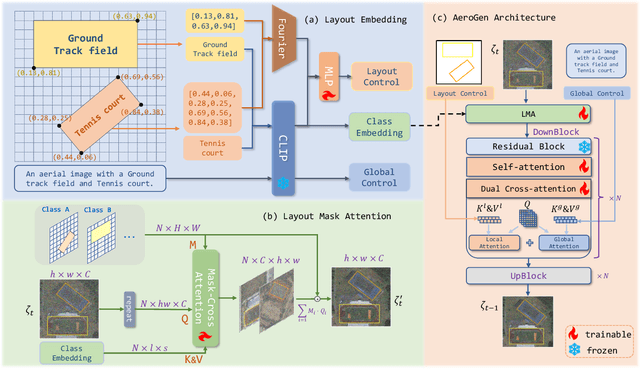

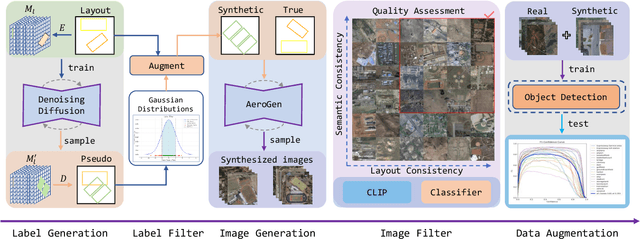
Abstract:Remote sensing image object detection (RSIOD) aims to identify and locate specific objects within satellite or aerial imagery. However, there is a scarcity of labeled data in current RSIOD datasets, which significantly limits the performance of current detection algorithms. Although existing techniques, e.g., data augmentation and semi-supervised learning, can mitigate this scarcity issue to some extent, they are heavily dependent on high-quality labeled data and perform worse in rare object classes. To address this issue, this paper proposes a layout-controllable diffusion generative model (i.e. AeroGen) tailored for RSIOD. To our knowledge, AeroGen is the first model to simultaneously support horizontal and rotated bounding box condition generation, thus enabling the generation of high-quality synthetic images that meet specific layout and object category requirements. Additionally, we propose an end-to-end data augmentation framework that integrates a diversity-conditioned generator and a filtering mechanism to enhance both the diversity and quality of generated data. Experimental results demonstrate that the synthetic data produced by our method are of high quality and diversity. Furthermore, the synthetic RSIOD data can significantly improve the detection performance of existing RSIOD models, i.e., the mAP metrics on DIOR, DIOR-R, and HRSC datasets are improved by 3.7%, 4.3%, and 2.43%, respectively. The code is available at https://github.com/Sonettoo/AeroGen.
RoboGSim: A Real2Sim2Real Robotic Gaussian Splatting Simulator
Nov 18, 2024Abstract:Efficient acquisition of real-world embodied data has been increasingly critical. However, large-scale demonstrations captured by remote operation tend to take extremely high costs and fail to scale up the data size in an efficient manner. Sampling the episodes under a simulated environment is a promising way for large-scale collection while existing simulators fail to high-fidelity modeling on texture and physics. To address these limitations, we introduce the RoboGSim, a real2sim2real robotic simulator, powered by 3D Gaussian Splatting and the physics engine. RoboGSim mainly includes four parts: Gaussian Reconstructor, Digital Twins Builder, Scene Composer, and Interactive Engine. It can synthesize the simulated data with novel views, objects, trajectories, and scenes. RoboGSim also provides an online, reproducible, and safe evaluation for different manipulation policies. The real2sim and sim2real transfer experiments show a high consistency in the texture and physics. Moreover, the effectiveness of synthetic data is validated under the real-world manipulated tasks. We hope RoboGSim serves as a closed-loop simulator for fair comparison on policy learning. More information can be found on our project page https://robogsim.github.io/ .
GAN-Based Architecture for Low-dose Computed Tomography Imaging Denoising
Nov 14, 2024



Abstract:Generative Adversarial Networks (GANs) have surfaced as a revolutionary element within the domain of low-dose computed tomography (LDCT) imaging, providing an advanced resolution to the enduring issue of reconciling radiation exposure with image quality. This comprehensive review synthesizes the rapid advancements in GAN-based LDCT denoising techniques, examining the evolution from foundational architectures to state-of-the-art models incorporating advanced features such as anatomical priors, perceptual loss functions, and innovative regularization strategies. We critically analyze various GAN architectures, including conditional GANs (cGANs), CycleGANs, and Super-Resolution GANs (SRGANs), elucidating their unique strengths and limitations in the context of LDCT denoising. The evaluation provides both qualitative and quantitative results related to the improvements in performance in benchmark and clinical datasets with metrics such as PSNR, SSIM, and LPIPS. After highlighting the positive results, we discuss some of the challenges preventing a wider clinical use, including the interpretability of the images generated by GANs, synthetic artifacts, and the need for clinically relevant metrics. The review concludes by highlighting the essential significance of GAN-based methodologies in the progression of precision medicine via tailored LDCT denoising models, underlining the transformative possibilities presented by artificial intelligence within contemporary radiological practice.
ParaGAN: A Scalable Distributed Training Framework for Generative Adversarial Networks
Nov 06, 2024
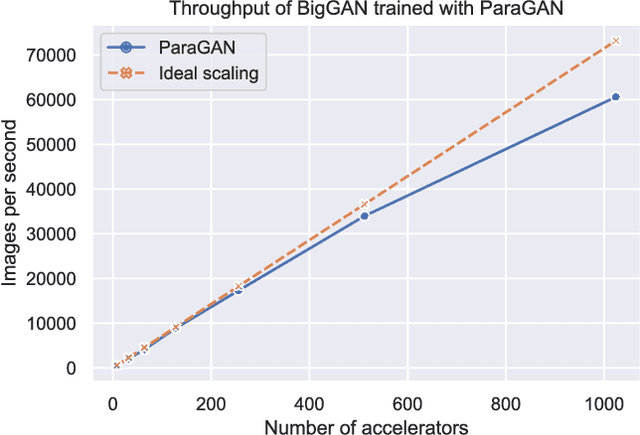
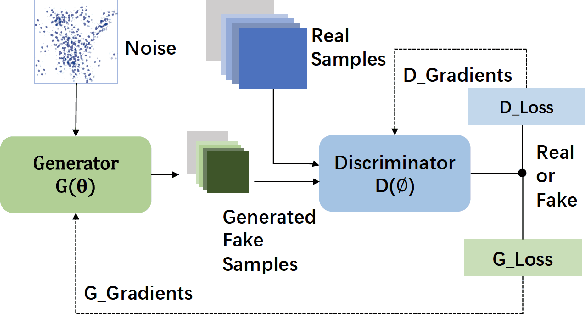
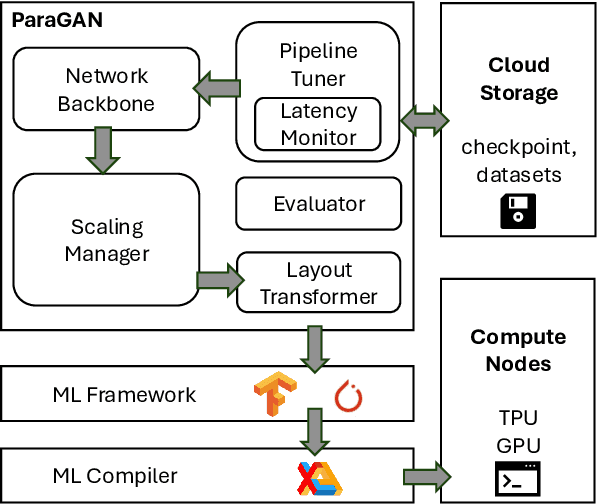
Abstract:Recent advances in Generative Artificial Intelligence have fueled numerous applications, particularly those involving Generative Adversarial Networks (GANs), which are essential for synthesizing realistic photos and videos. However, efficiently training GANs remains a critical challenge due to their computationally intensive and numerically unstable nature. Existing methods often require days or even weeks for training, posing significant resource and time constraints. In this work, we introduce ParaGAN, a scalable distributed GAN training framework that leverages asynchronous training and an asymmetric optimization policy to accelerate GAN training. ParaGAN employs a congestion-aware data pipeline and hardware-aware layout transformation to enhance accelerator utilization, resulting in over 30% improvements in throughput. With ParaGAN, we reduce the training time of BigGAN from 15 days to 14 hours while achieving 91% scaling efficiency. Additionally, ParaGAN enables unprecedented high-resolution image generation using BigGAN.
A Lightweight Multi Aspect Controlled Text Generation Solution For Large Language Models
Oct 18, 2024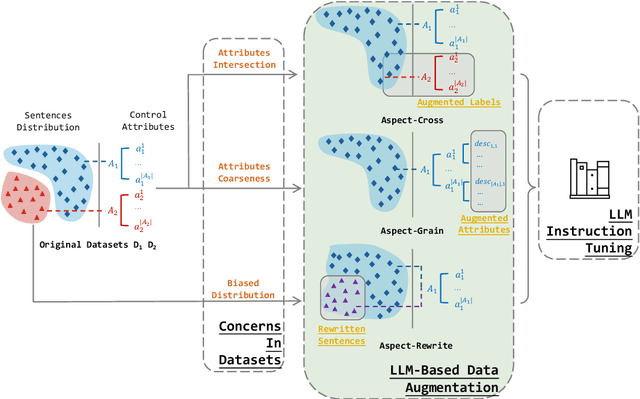

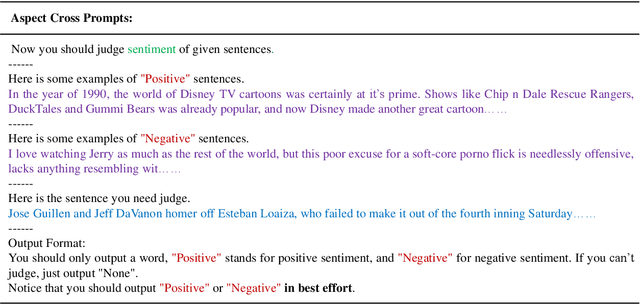

Abstract:Large language models (LLMs) show remarkable abilities with instruction tuning. However, they fail to achieve ideal tasks when lacking high-quality instruction tuning data on target tasks. Multi-Aspect Controllable Text Generation (MCTG) is a representative task for this dilemma, where aspect datasets are usually biased and correlated. Existing work exploits additional model structures and strategies for solutions, limiting adaptability to LLMs. To activate MCTG ability of LLMs, we propose a lightweight MCTG pipeline based on data augmentation. We analyze bias and correlations in traditional datasets, and address these concerns with augmented control attributes and sentences. Augmented datasets are feasible for instruction tuning. In our experiments, LLMs perform better in MCTG after data augmentation, with a 20% accuracy rise and less aspect correlations.
 Add to Chrome
Add to Chrome Add to Firefox
Add to Firefox Add to Edge
Add to Edge